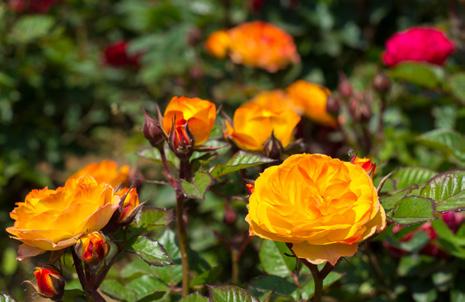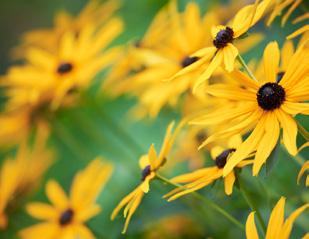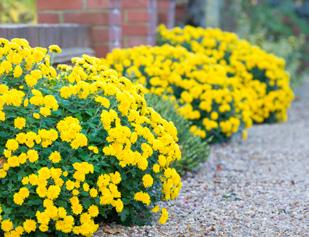
5 minute read
Enjoy Your Garden for Longer this Autumn
with Dobbies
As summer draws to a close, people are looking for ways to extend their time outdoors and make the most of their gardens while they can. According to Dobbies, autumn is the perfect time to refresh your outdoor space, regardless of size, and take advantage of the cooler temperatures that the season brings.
Advertisement
As summer draws to a close, people are looking for ways to extend their time outdoors and make the most of their gardens while they can. According to Dobbies, autumn is the perfect time to refresh your outdoor space, regardless of size, and take advantage of the cooler temperatures that the season brings. Dobbies’ Horticultural Director, Marcus Eyles says that contrary to what some might think, autumn is not a season of the shutdown. There are plenty of things to be getting on with that will extend the colour in your garden from late summer into early autumn, and then as we get into late autumn, there are ways that we can prepare our gardens for winter. Here are some top tips on how to get the most out of your garden this autumn and enjoy it for longer.
Autumn - The New Gardening Season
Contrary to popular belief, we shouldn’t cut back all flowers and plants in autumn. Summer bedding plants are fine to leave in and just deadhead and they should continue to flower until the first frost. Roses can also continue to flower well into autumn so continue to remove them as soon as they go over to encourage more. In terms of what should be pruned, late summer flowering shrubs should be cut back immediately once they finish flowering to ensure they bloom well next year.
Grasses and Hydrangeas should be enjoyed in autumn and will last well into winter when they become decorated with dew and frost, so avoid cutting these back. Leaving your borders with foliage and flower stems will also encourage wildlife to thrive and give them a space to shelter during the colder months.
As we get into late autumn, Marcus recommends putting plants into covered protection to continue growth.

Herbs can be placed into a grow house, cold frame or windowsill so you have fresh homegrown leaves over the winter. Micro-greens and salad leaves can be grown indoors with supplementary light to make sure you have fast-growing, healthy crops throughout the year.
Seasonal Refresh and Planting
Early autumn is the perfect time to refresh your garden with colourful blooms. Bring some of the season’s signature warm colours, such as ochre and orange, to your outdoor space by using Chrysanthemums, Crocosmia and Rudbeckia. Even add some purple, pink and white to really catch the eye with seasonal plants like Echinacea, Anemone and Hebe.


Redecorate your garden by refreshing containers and hanging baskets with seasonal plants such as Pansies, Violas and Wallflowers that will last through winter and brighten up your garden through the cold months.


From mid-August, it’s time to start planting spring flowering bulbs such as Snowdrops, Crocuses, Daffodils and Tulips for a colourful display that will start to bloom as early as next February.
The autumn flowering Saffron Crocus is a fantastic choice for those looking to add colour to their garden and should be planted with Dobbies’ Peat Free No 3 Mature Plant Compost, which recently won RHS Chelsea Sustainable Product of the Year. As these plants are typically grown in woodland areas, they can be planted either in pots or in beds beside shrubs and trees. If you are planting in pots, make sure you reposition these near your doorway in late autumn so you can appreciate their fresh cheerful flowers.
Grow your own
Early autumn is a fantastic time to grow delicious fresh produce, and some mini vegetables can even be harvested in time for your Christmas dinner! Potatoes are a top choice for planting in late summer and early autumn as they grow quickly, so if you plant them now, you’ll have fresh potatoes by December. What’s more, once potatoes are planted, they take very little looking after, meaning they’re great for people just starting their gardening journey. For best results, it’s recommended that you sow potatoes in large containers in a sunny spot and use Dobbies’ Peat Free Multipurpose Compost. Carrots can also be sown in early autumn and grow well in an open site with fertile, well-drained soil, and these can also be grown in deep containers. Carrots don’t need too much water, although if your garden experiences long periods without rain, they will appreciate a generous watering every couple of weeks. To prevent carrot flies from damaging your crop, cover them with insect mesh, and harvest your carrots as soon as they are large enough to use - usually 12 to 16 weeks after sowing.
If you’re looking to grow your own produce in late autumn, there is still time to get planting for a winter harvest. Kale is a hardy vegetable that can be grown at home, even during the coldest months, and is great for planting in raised beds or containers. Marcus recommends an insect mesh to cover the crop and prevent caterpillars from accessing the crop, and you should water the kale regularly, picking the leaves weekly as they grow to ensure they don’t start to flower.
Lawncare
If you like an ornamental lawn, you should begin to remove moss and dead grass with a wire rake or electric scarifier in autumn and use an aerator to take out the old soil and allow better movement of air and water. Once you’ve done this, use a peat-free lawn dressing to refresh the soil and help fix any dips and troughs and finally sow some fresh grass seed. For a more wildlifefriendly lawn with meadow-like grass, you should hold off as long as possible in terms of mowing and start to cut in early autumn, once you’re sure the flower seeds have dropped. In late autumn, when leaves begin to fall, make sure you remove them from your lawn as soon as possible, as they will block air and sunlight; two essential things that grass needs to survive. Autumn sown grass seed will germinate ahead of winter and help fill in any sparse areas ahead of the first frost.
Sustainable Gardening
When tending to your garden this autumn, Marcus stresses the importance of keeping sustainable practices at the forefront of your gardening. Late autumn is a great time to start making your own compost if you haven’t already, and creating your own compost at home couldn’t be easier.
One of the most important things when it comes to composting is ensuring you have a good balance of green materials, such as fruit and vegetable peelings, grass clippings, eggshells and teabags, and brown materials, such as weeds, dead leaves, sawdust, and bark. Green materials supply most of the nutrients in your compost, which in turn will enrich your garden, and brown materials bulk out your compost, add organic matter and allow air to filter through the pile. To ensure an effective compost, use roughly four parts brown materials to one part green materials. And whilst you can compost most food waste, don’t compost meat, fish and dairy as this can attract flies and unwanted pests.
When working on your beds and borders, Marcus says that mulching well with peatfree compost or Bloomin Amazing will ensure good soil health and help to keep weeds at bay, meaning you can avoid using any harsh chemical weed killers that could be harmful to both wildlife and the environment.
Your Autumn Gardening Toolkit:
• Dobbies’ Peat Free Compost from £3.99
• Composter, HotBin Mini Compost Bin 100L £199.99
• Wire rake, Stainless Steel Long Handled Lawn/ Leaf Rake £34.99
• Electric scarifier, Webb 36cm Scarifier £159.99

• Good quality gardening gloves, Gold Leaf Soft Touch Gloves £24.99
• Secateurs, RHS Pro Bypass Secateur Burgon & Ball £34.99
For more gardening advice and inspiration visit www.dobbies.com










